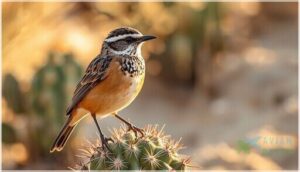This site is supported by our readers. We may earn a commission, at no cost to you, if you purchase through links.
 Most desert birds sip water when they can find it, but the cactus wren has mastered a trick that keeps it thriving where temperatures soar past 100 degrees. This rust-colored songbird with bold white eyebrows gets 97% of its water from the insects it hunts, rarely drinking at all.
Most desert birds sip water when they can find it, but the cactus wren has mastered a trick that keeps it thriving where temperatures soar past 100 degrees. This rust-colored songbird with bold white eyebrows gets 97% of its water from the insects it hunts, rarely drinking at all.
At seven to nine inches long, it’s the largest wren in North America and one of the few birds tough enough to build nests inside cholla cactus spines. You’ll spot these birds hopping along the ground in Southwestern deserts, their loud rattling calls cutting through the morning heat.
Understanding how this bird survives helps explain why protecting desert habitats matters more than ever.
Table Of Contents
- Key Takeaways
- Cactus Wren Identification and Appearance
- Habitat and Geographic Range
- Behavior and Daily Life
- Diet and Feeding Preferences
- Conservation Status and Threats
- Frequently Asked Questions (FAQs)
- What is a cactus wren?
- Are cactus wrens active?
- Do cactus wrens live in southwestern deserts?
- Why is it called Cactus Wren?
- Where do cactus wrens build their nests?
- What is the difference between a thrasher and a Cactus Wren?
- Why did Arizona pick the Cactus Wren?
- How long do cactus wrens typically live?
- What predators pose a threat to adult cactus wrens?
- Can cactus wrens be kept as pets or rehabilitated?
- Conclusion
Key Takeaways
- The cactus wren gets almost all its water from insects, allowing it to survive in deserts where rain is rare.
- This bird builds football-shaped nests inside thorny cacti, which protect eggs and young from predators and heat.
- Habitat loss, wildfires, and invasive plants have caused cactus wren populations to drop over 50% since 1966.
- Conservation efforts focus on restoring cactus-rich habitats and connecting fragmented populations to support their survival.
Cactus Wren Identification and Appearance
You can spot a Cactus Wren from quite a distance if you know what to look for. This bird has a distinctive build and unique markings that set it apart from other desert species.
Here’s what makes the Cactus Wren easy to identify in the wild.
Physical Characteristics and Size
As the largest wren in the United States, the cactus wren measures 7.1 to 9.1 inches long with a wingspan reaching 10.6 to 11 inches. Body dimensions include a width of 1.8 to 2.4 inches and height of 3.7 to 4.7 inches. Adults weigh between 1.1 and 1.7 ounces.
Males and females show virtually no sexual dimorphism in size or measurements. These birds are year-round residents in their territory.
Distinctive Plumage and Markings
Beyond just size, you can identify the cactus wren by its bold color pattern and feather patterns. Look for these distinctive bird physical characteristics:
- Bright white eyebrow stripe running from bill to nape
- Brown back heavily streaked with white and black plumage patterns
- White chest covered in dark spots
- Cinnamon underparts on flanks and sides
- Barred tail with alternating black and pale bands
Facial markings stay consistent year-round, though seasonal markings fade slightly during summer molting.
The wren thrives in desert environments, making its home in southern California and other arid regions. Regional variation exists across desert populations, with some showing heavier spotting than others.
Comparison With Similar Desert Birds
You’ll often spot the cactus wren alongside other desert bird species in the same arid environment. Curve-billed thrashers share similar habitat overlap and nesting preferences—both favor cholla for nests. However, size variations are notable: thrashers have longer tails and bills.
Foraging differences emerge too—black-tailed gnatcatchers glean insects from branches while cactus wrens probe ground litter.
Vocalizations distinguish them: the cactus wren’s harsh churr contrasts sharply with the thrasher’s melodious song and gnatcatcher’s high-pitched twitter.
Habitat and Geographic Range
The Cactus Wren makes its home in some of the hottest and driest places you can imagine. You’ll find these tough birds scattered across the southwestern deserts where most other species wouldn’t last a day.
Let’s look at where they live, how far their range extends, and what makes them so well-suited to desert life.
Preferred Desert and Arid Environments
You’ll find Cactus Wren habitat in deserts, arid foothills, coastal sage scrub, and desert scrub where thorny plants thrive. These birds prefer elevations below 1,200 meters with low rainfall and sparse canopy cover. Cactus density matters most for nesting sites. Native flora like cholla and prickly pear provide essential shelter.
Climate conditions stay hot and dry year-round. Habitat fragmentation threatens these specialized environments.
Distribution Across The United States and Mexico
You’ll find the Cactus Wren throughout southwestern deserts from southern California to Texas and deep into Mexico. Regional populations span elevations from sea level to 2,200 meters in central Mexican states. Geographic distribution includes seven subspecies with distinct habitat ranges.
In the United States, these birds occupy Nevada, Utah, Arizona, New Mexico, and California. Genetic clusters show variation across fragmented landscapes.
Adaptations to Hot, Dry Climates
To survive harsh desert environments and arid regions, the Cactus Wren relies on impressive water conservation and temperature regulation strategies. These bird adaptations include obtaining over 90% of water needs from insects and fruits.
Behavioral adaptations reduce activity during peak heat by 50%. Nesting solutions in cacti keep temperatures 8°C cooler.
Dietary utilization shifts seasonally for prime desert environment adaptation.
Behavior and Daily Life
The Cactus Wren lives life a bit differently than most wrens you’ll come across. It doesn’t hop around with its tail cocked up and it won’t shy away from being seen.
Let’s look at how this bold bird spends its days in the desert.
Foraging and Feeding Habits
You’ll notice Cactus Wrens start foraging late morning when desert temperatures cool down a bit. Their foraging behavior reveals considerable efficiency and adaptability:
- They flip over ground litter and probe bark crevices to hunt insects like beetles and grasshoppers
- Peak foraging happens at dawn and dusk when prey is most active
- Their seasonal diet shifts to include cactus fruit during summer months
- These birds get 97% of their water sources from food rather than drinking
- Prey selection focuses on large-bodied insects that provide essential proteins
During hot periods, they shift foraging to shaded spots beneath desert shrubs.
Social and Territorial Behaviors
Cactus Wrens defend territories between 3.2 and 4.7 acres year-round using loud scolding and aggressive chases. Physical aggression occurs in 30 percent of territorial disputes, especially near nest sites.
You’ll see 86 percent of territories occupied by monogamous pairs that maintain strong pair bonds throughout the year. These birds show considerable site fidelity, with 67 percent remaining in the same territory annually.
Nesting Strategies and Structures
Over 90 percent of breeding nests sit protected within cholla or prickly pear cacti, where sharp spines ward off predators. You’ll notice their football-shaped nests measure 20 to 25 centimeters long with side entrances facing away from the wind.
Key aspects of cactus wren nesting habits include:
- Nest construction starts in late February, with pairs building up to 5 nests per season
- Eggs generally number 4 to 5 per clutch during breeding timing
- Nest success reaches 72 percent in wet years versus 50 percent in dry conditions
- Survival strategies include dummy nests that serve as decoys and nighttime roosts
Incubation lasts 16 days, followed by 19 to 23 days before young fledge.
Diet and Feeding Preferences
The Cactus Wren’s diet reflects its desert lifestyle. These birds are opportunistic eaters that rely heavily on insects but also consume plant materials when available.
Understanding what they eat and how they find food reveals key survival strategies in harsh environments.
Primary Insect Prey
As insectivorous birds go, you’ll find cactus wrens thriving on arthropods that fuel their desert survival. Their diet shows clear Lepidoptera dominance at up to 41% during breeding season.
These birds also rely on Coleoptera consumption and ant consumption for protein. Spider importance can’t be overlooked since spiders provide 7–14% of nestling meals.
Remarkably, insects serve as the primary hydration source, supplying over 80% of their daily water needs.
Plant-Based Foods and Seasonal Variations
While insects dominate the menu, you’ll notice plant-based foods making up 17–20% of the Cactus Wren Diet. Seasonal Shifts are key here.
During summer heat, cactus fruits like prickly pear and saguaro provide both nutrition and hydration. Fruit Consumption peaks when berries ripen, and Seed Intake rises in fall and winter as insects decline. Nectar Use from saguaro blossoms aids spring hydration.
Habitat Associations with elderberry and buckwheat boost access to diverse food sources year-round.
Foraging Techniques and Food Acquisition
To find food, you’ll see these birds flip over rocks and debris, which boosts Prey Capture Success by 2.5 times compared to surface searching alone. Ground Foraging Dominance is clear—they spend roughly 90% of their time hunting on the ground.
Canopy Resource Use happens too, especially in cholla and prickly pear during breeding season. Their Dietary Adaptations help them thrive where other songbirds can’t.
Conservation Status and Threats
The Cactus Wren isn’t currently endangered, but its numbers tell a concerning story. Over the past few decades, populations have dropped considerably across their range, especially in areas where desert habitat continues to shrink.
Understanding where these birds stand today, what threatens their survival, and how conservation efforts are working to help them gives you the full picture of their future.
Current Population Trends
You’ll notice the cactus wren’s conservation status shows concerning decline causes across its range. The bird’s populations dropped over 50% between 1966 and 2019, with regional variation most severe in Texas and coastal California.
Cactus wren populations have plummeted over 50% since 1966, with the steepest declines hitting Texas and coastal California
Breeding success rates improve during wet years but genetic diversity suffers from habitat fragmentation. Despite being listed as “least concern,” the future outlook indicates continued decreases without intervention.
Threats to Survival and Habitat Loss
You’ll find habitat fragmentation poses the biggest threat to cactus wren survival. Urban sprawl has destroyed over 85% of coastal sage scrub in southern California.
Wildfire impacts eliminate entire territories, and cactus stands need years to recover. Invasive species overtop cacti at 61% of surveyed sites, while genetic isolation weakens small populations.
Predators, including snakes and hawks, further reduce nesting success in these declining habitats.
Conservation Efforts and Protection Initiatives
You’ll see habitat restoration programs targeting 46 sites on conserved lands, with over 3,200 cactus pads planted across five locations. Population monitoring tracks occupancy rates—now at 34% in 2025.
Connectivity linkages bridge isolated populations using stepping stone patches up to 2 km apart.
Cooperative planning between agencies ensures management outcomes meet survival benchmarks, with annual performance reports documenting bird conservation status improvements despite ongoing wild status challenges from bird predators.
Frequently Asked Questions (FAQs)
What is a cactus wren?
You’ll recognize the cactus wren by its impressive size and bold markings. This desert adaptation specialist measures 7 to 9 inches long.
It’s the largest wren species in the United States with distinctive physical characteristics.
Are cactus wrens active?
You’ll observe peak activity around sunrise when these desert birds forage actively. They remain active year-round with diurnal daily rhythms.
Temperature influence causes midday slowdowns as they seek shade during extreme desert heat.
Do cactus wrens live in southwestern deserts?
Yes, cactus wrens thrive in southwestern deserts across the United States and Mexico. You’ll find them throughout the Sonoran, Mojave, and Chihuahuan deserts, where dense cacti and thorny shrubs provide ideal nesting sites and foraging opportunities.
Why is it called Cactus Wren?
The name reflects its strong connection to cactus-rich environments where it builds nests and forages.
This wren depends on thorny shrubs and cacti throughout southwestern deserts, making the habitat connection central to its identity and survival.
Where do cactus wrens build their nests?
You’ll find their football-shaped nests tucked into thorny shrubs and desert cactus plants like cholla, saguaro, and prickly pear.
They weave these sturdy structures from grasses, twigs, and plant fibers at heights between 2 and 10 feet.
What is the difference between a thrasher and a Cactus Wren?
For telling these birds apart, size variation is your first clue. Thrashers are larger with longer tails and straight bills. Cactus Wrens show bold white eyebrows and heavily spotted breasts.
Why did Arizona pick the Cactus Wren?
Arizona chose the Cactus Wren as its state bird in 1931 because this desert resident symbolizes resilience and adaptability.
The legislative process recognized how perfectly this bold bird represents the state’s rugged landscape and inventive spirit.
How long do cactus wrens typically live?
The bird life cycle of desert species faces challenges from predator pressure and environmental threats.
Average lifespan ranges from two to eight years, though maximum lifespan can reach seven years when habitat impact remains minimal.
What predators pose a threat to adult cactus wrens?
You’ll see avian predators like Cooper’s Hawks and roadrunners hunting adult wrens. Mammalian threats include coyotes, foxes, and domestic cats. Reptilian predators such as coachwhips target adults too, prompting defensive mobbing behavior.
Can cactus wrens be kept as pets or rehabilitated?
You can’t legally keep cactus wrens as pets. Federal law protects them under the Migratory Bird Treaty Act.
Licensed rehabilitators can care for injured birds temporarily before releasing them back to their natural habitat.
Conclusion
While most songbirds need daily trips to water sources, the cactus wren thrives in places where rain mightn’t fall for months. Its ability to extract moisture from insects and build fortress-like nests in spiny cacti shows striking adaptation.
But these survival skills mean nothing if we lose the desert landscapes they call home. Protecting these arid habitats ensures this tough little bird continues its morning rattles across the Southwest for generations to come.










